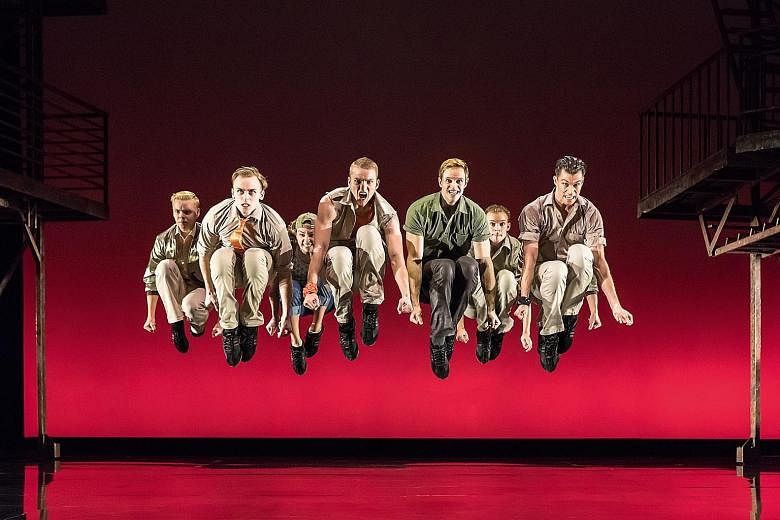For many restaged musicals, the director usually aims to give the production a facelift from the previous run, to keep things relevant.
But New York-based director- choreographer Joey McKneely has a different mission and vision for his restaging of West Side Story, now showing at the MasterCard Theatres at Marina Bay Sands.
His version, which will head to other cities including Bangkok, Paris and Shanghai after Singapore, preserves the musical's original choreography by legendary American choreographer Jerome Robbins, which was first seen in 1957 when the production burst onto Broadway.
Robbins' dance routines are exhilarating; full of lifts, jumps, provocative finger-snapping and whirling skirts.
McKneely, 50, was Robbins' protege and came under his tutelage in 1989, first as a dancer in Jerome Robbins' Broadway, an anthology comprising musical numbers from shows that were either directed or choreographed by Robbins.
Robbins died in 1998 and, today, McKneely is among the few artistes in the world with the licence to stage West Side Story with Robbins' original choreography.
West Side Story is inspired by Shakespeare's tumultuous love story Romeo And Juliet and takes place in 1950s New York. Two rival street gangs, the Jets and the Sharks, are jostling for domination in the Upper West Side neighbourhood. Things get complicated when Tony, a Jet, and Maria, sister of the leader of the Sharks, fall in love.
-
BOOK IT / WEST SIDE STORY
-
WHERE: MasterCard Theatres at Marina Bay Sands, 10 Bayfront Avenue
WHEN: Until Sept 30, 8pm (Tuesdays to Fridays); 2 and 8pm (Saturdays); 1 and 6pm (Sundays)
ADMISSION: From $55 from Sistic (call 6348-5555 or go to www.sistic.com.sg) or MBS box offices (call 6688-8826 or go to www.marinabaysands.com/ticketing)
McKneely says Robbins' choreography is powerful and remains relevant today because it is key to the development of the storyline and because the issue of racism - the subject matter of the show - is an ongoing one.
"It never feels dated," he says.
"Robbins' concept was to create and build up characters using choreography. The choreography is the dialogue. Every dancer is a character and so much emotion is delivered through their movements."
He has watched West Side Story without Robbins' choreography and says that "something gets lost" when that is absent from the show.
He points to how Robbins' choreography opens the show. For the first three minutes of the show, the audience is introduced to the characters and the conflict - without words.
Later in the show, there is a stabbing scene. McKneely says such a scene can be concluded in just "10 to 15 seconds", but Robbins was able to choreograph an entire scene around it.
The most important principle that Robbins left with McKneely is that the choreography comes first, and the dancers, second.
"If the dancer can't execute the choreography, switch the dancer. Don't change the choreography. Change the dancer," says McKneely of Robbins' words to him.
While staying true to the original, there are "little tiny things" he has introduced to make the production more exciting.
There are new costumes, new lighting effects and some moves have been tweaked to give characters more edge and energy.
In the scene America, the audience will also see bigger jumps, which he says have replaced what used to be "little jumps".
Bigger jumps are possible because today's dancers are more powerful and athletic compared with those in 1957, he says.
He views the number Cool as the hardest dance in the show.
"It's so hard stamina-wise. The dancers have to keep jumping off the ground."
Dancer Kyle Weiler, 23, who is performing in the production, agrees that Cool is the most physically demanding sequence in the musical.
The American says: "There is a lot of jumping and floorwork, turns and sliding. There is also an iconic move in this scene - the crouch jump."
The image of the dancers doing the crouch jump - bodies bent forward, with knees bent, almost touching the chest - is often seen in the production's publicity posters.
Because the show is so physically gruelling for the dancers, they warm up with ballet classes at least four times a week before practising all the show's fight sequences and lifts.
Americans Jenna Burns and Marc Koeck, who play the leads Maria and Tony, say their scenes involve a lot of physicality too.
Burns, 25, experiences intense grief in one of the show's final scenes and the emotions call for her to jump, run, throw her body forward and scream.
During the show, there is a scene in which Tony is searching for Maria. That scene requires Koeck, 26, to jump up onto and down from ladders.
"There's singing, acting and movement going on in this adrenaline- charged scene. By the end of it, my heart is racing," he says.
McKneely considers it "an absolute privilege" to have the rights to stage West Side Story with Robbins' original choreography.
He says: "I'm carrying a torch that someone gave to me. Someday, I'll have to pass the torch on to someone else.
"Until that day, it is important to hold the choreography - this torch I'm holding - to the highest standard I was entrusted with."


